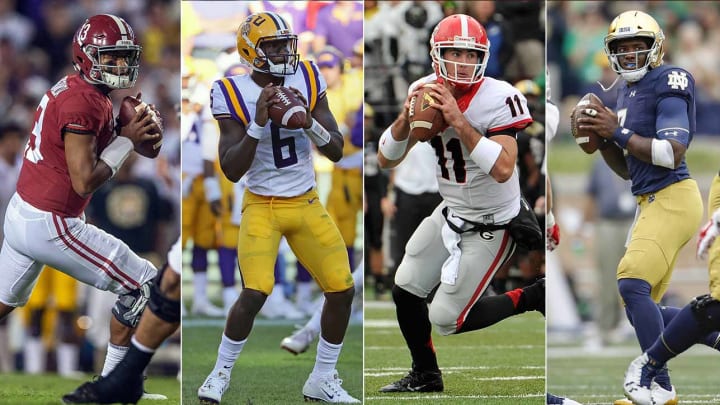Alabama, Georgia, LSU and Notre Dame Show Not All Quarterback Turnover Is the Same

This time of year, as recruiting classes are finalized, the transfer market settles and spring football’s position battles take shape, it can be difficult to keep track of the old faces in new places. That’s especially true at quarterback, a position where top prospects frequently transfer at least once in their college careers. Some players realize they’ll never get a shot at their first school; others are established starters who lose their jobs and move on.
Some of the best programs in the country have embraced the concept of the quarterback revolving door. Since the 2012 season, 12 schools have overall winning percentages greater than .700, but just four of those have had more than four quarterbacks start double-digit games over that time period.
It may be easier to win with some consistency under center, but competition can drive a program forward, even if it upsets the status quo or forces a head coach to reshape his vision for the year to come. That has been the case in recent years at Alabama and Georgia, each of which have seen five players start 10 or more games since 2012.
It also proves that a great team can be more than its quarterback, or that it can win in spite of him. That was once the case for Alabama, but now it more accurately applies to the other two teams on this list: Notre Dame and LSU, who have seen on- and off-field disappointments limit their QB rooms’ output. And still, they’ve won.
With that in mind, let’s take a look at exactly how (and why) these four programs managed to churn through so many quarterbacks for the better part of this decade and keep on winning.
Alabama (.910 winning percentage since 2012)
Regular starters: AJ McCarron, Blake Sims, Jake Coker, Jalen Hurts, Tua Tagovailoa.
How it worked: Nick Saban’s quarterback decisions in Tuscaloosa haven’t lacked for drama, but they have worked out just fine. In the past, the Crimson Tide were powered by an elite defense and simply needed game managers, albeit very good ones, to keep the offense humming. That philosophy began to evolve with the emergence of dual-threat Jalen Hurts and changed forever with the insertion of Tua Tagovailoa to win the national championship game after the 2017 season. Tagovailoa should be a first-round pick when he comes out.
Of the five players who’ve started for Alabama since 2012, four have played a direct hand in a national championship. McCarron led the Crimson Tide’s successful national title defense in 2012. Coker transferred from Florida State, backed up Sims for a year and then quarterbacked the 2015 Tide to a championship. After opening the 2016 season behind Blake Barnett, Hurts took control of the job and became the first true freshman to start for Alabama since 1984, leading the team to the next two title games only to be famously sidelined for Tagovailoa in the unforgettable comeback over Georgia.
Georgia (.758)
Regular starters: Aaron Murray, Hutson Mason, Greyson Lambert, Jacob Eason, Jake Fromm
How it worked: Georgia’s past seven seasons of quarterback play resemble Alabama’s: shuffling in the wake of a multi-year starter’s departure, followed by a freshman stealing the job from the upperclassman considered a multi-year solution. Since 2012, the Bulldogs have evolved from consistency under Murray to a few subpar seasons to a competition that saw the departure of one top recruit. It certainly could be worse.
Murray was a four-year starter for Mark Richt from 2010 to ’13, and Mason took over in ’14 for his final year of eligibility after backing up Murray for three years. With no successor ready after Mason’s year ended with a top-15 finish but two untimely SEC East losses, Georgia reeled in Virginia transfer Lambert to start in 2015, Richt’s final year in Athens. New head coach Kirby Smart handed things over to five-star freshman Eason, but a Week 1 injury in 2017 left him to yield to another true freshman, and Fromm has gone 24–5 as a starter to lead the program out of its mid-decade dip in national contention.
Notre Dame (.722)
Regular starters: Everett Golson, Tommy Rees, DeShone Kizer, Brandon Wimbush, Ian Book
How it worked: Former four-star prospect Malik Zaire had several chances to play his way into the group of double-digit starters, but injuries and ineffectiveness led him to only start seven games for the Fighting Irish. But let’s focus on who actually meets the threshold.
Golson appeared destined for a decorated career when he led the Irish to the BCS title game in 2012, but he was suspended for academic misconduct the following fall, hand the ball to his former backup Rees (the Irish starter in 2011) for the year. Golson started again in ’14, then left for Florida State as a graduate transfer in ’15. From there, the job was supposed to go to Zaire, who broke his leg, and Kizer took over for one excellent year and one 4–8 campaign. In 2017, Wimbush started as a junior with little backup experience, and last fall his backup, Book, supplanted him.
It’s been an up-and-down decade for Notre Dame, and that can be attributed to much more than its quarterbacks. Still, volatility at that position hasn’t helped the Irish, who have been exposed by turnover-seeking defenses and, in the case of the 2018 playoff semifinals, a superior QB on the other side of the field. Book has earned his chance to stick as the guy again next fall, and he should be able to keep Notre Dame on the upswing.
LSU (.719)
Regular starters: Zach Mettenberger, Anthony Jennings, Brandon Harris, Danny Etling, Joe Burrow
How it worked: LSU presents a classic case of winning in spite of its quarterback, cycling in a large cast of potential successors in an effort to replace Mettenberger, who arrived in Baton Rouge in 2011 and had a stronger hold on the job over the ’12 and ’13 seasons than any QB has since for the Tigers. Jennings and Harris each spent one year in the starting role, lost their jobs and transferred. Etling, a Purdue transfer, took the bulk of LSU’s snaps for two seasons and brought a measure of stability, and last fall, Ohio State transfer Joe Burrow arrived, prompting two LSU QBs (Justin McMillan and Lowell Narcisse) to bolt from Baton Rouge before Week 1.
Thirteen quarterbacks have attempted at least one pass for LSU since 2012. In that time, the team has fielded some of the best defenses in the country, as well as several top running backs, which has more than compensated for the chaos that has often reigned at quarterback. Burrow has another year of eligibility remaining, and in year two with him under center next fall, the Tigers have a chance to build on the 10–3 mark they put up last fall and achieve some rare stability at the game’s most important position.
